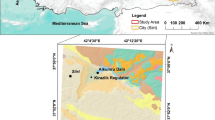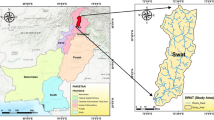Abstract
The scientific and fair positioning of monitoring locations for surface displacement on slopes is a prerequisite for early warning and forecasting. However, there is no specific provision on how to effectively determine the number and location of monitoring points according to the actual deformation characteristics of the slope. There are still some defects in the layout of monitoring points. To this end, based on displacement data series and spatial location information of surface displacement monitoring points, by combining displacement series correlation and spatial distance influence factors, a spatial deformation correlation calculation model of slope based on clustering analysis was proposed to calculate the correlation between different monitoring points, based on which the deformation area of the slope was divided. The redundant monitoring points in each partition were eliminated based on the partition’s outcome, and the overall optimal arrangement of slope monitoring points was then achieved. This method scientifically addresses the issues of slope deformation zoning and data gathering overlap. It not only eliminates human subjectivity from slope deformation zoning but also increases the efficiency and accuracy of slope monitoring. In order to verify the effectiveness of the method, a sand-mudstone interbedded Counter-Tilt excavation slope in the Chongqing city of China was used as the research object. Twenty-four monitoring points deployed on this slope were monitored for surface displacement for 13 months. The spatial location of the monitoring points was discussed. The results show that the proposed method of slope deformation zoning and the optimized placement of monitoring points are feasible.
Similar content being viewed by others
References
Angeli MG, Pasuto A, Silvano S (2000) A critical review of landslide monitoring experiences. Eng Geol 55(3): 133–147. https://doi.org/10.1016/S0013-7952(99)00122-2
Adler J, Parmryd I (2010) Quantifying colocalization by correlation: the Pearson correlation coefficient is superior to the Mander’s overlap coefficient. Cytom Part A 77(8): 733–742. https://doi.org/10.1002/cyto.a.20896
Atzeni C, Barla M, Pieraccini M, et al. (2015) Early warning monitoring of natural and engineered slopes with ground-based synthetic-aperture radar. Rock Mech Rock Eng 48: 235–246. https://doi.org/10.1007/s00603-014-0554-4
Azarfar B, Ahmadvand S, Sattarvand J, et al. (2019) Stability analysis of rock structure in large slopes and open-pit mine: numerical and experimental fault modeling. Rock Mech Rock Eng 52: 4889–4905. https://doi.org/10.1007/s00603-019-01915-4
Auflič MJ, Herrera G, Mateos RM (2023) Landslide monitoring techniques in the Geological Surveys of Europe. Landslides 20(5): 951–965. https://doi.org/10.1007/s10346-022-02007-1
Bodenhofer U, Kothmeier A, Hochreiter S (2011) APCluster: an R package for affinity propagation clustering. Bioinformatics 27(17): 2463–2464. https://doi.org/10.1093/bioinformatics/btr406
Bellone T, Dabove P, Manzino AM, et al. (2016) Real-time monitoring for fast deformations using GNSS low-cost receivers. Geomat Nat Haz Risk 7(2): 458–470. https://doi.org/10.1080/19475705.2014.966867
Berg N, Smith A, Russell S, et al. (2018) Correlation of acoustic emissions with patterns of movement in an extremely slow-moving landslide at Peace River, Alberta, Canada. Can Geotech J 55(10): 1475–1488. https://doi.org/10.1139/cgj-2016-0668
Calcaterra S, Cesi C, Di Maio C, et al. (2012) Surface displacements of two landslides evaluated by GPS and inclinometer systems: a case study in Southern Apennines, Italy. Nat Hazards 61: 257–266. https://doi.org/10.1007/s11069-010-9633-3
Cina A, Piras M (2015) Performance of low-cost GNSS receiver for landslides monitoring: Test and results. Geomat Nat Haz Risk 6(5–7):497–514. https://doi.org/10.1080/19475705.2014.889046
Chae BG, Park HJ, Catani F, et al. (2017) Landslide prediction, monitoring and early warning: a concise review of state-of-the-art. Geosci J 21: 1033–1070. https://doi.org/10.1007/s12303-017-0034-4
Carlà T, Tofani V, Lombardi L, et al. (2019) Combination of GNSS, satellite InSAR, and GBInSAR remote sensing monitoring to improve the understanding of a large landslide in high alpine environment. Geomorphology 335: 62–75. https://doi.org/10.1016/j.geomorph.2019.03.014
Cenni N, Fiaschi S, Fabris M (2021) Integrated use of archival aerial photogrammetry, GNSS, and InSAR data for the monitoring of the Patigno landslide (Northern Apennines, Italy). Landslides 18: 2247–2263. https://doi.org/10.1007/s10346-021-01635-3
Dudoit S, Fridlyand J (2002) A prediction-based resampling method for estimating the number of clusters in a dataset. Genome biol 3(7): 1–21. https://doi.org/10.1186/gb-2002-3-7-research0036
Durville JL, Bonnard C, Potherat P (2011) The Séchilienne (France) landslide: a non-typical progressive failure implying major risks. J Mt Sci 8(2): 117–123. https://doi.org/10.1007/s11629-011-2086-7
Frey BJ, Dueck D (2007) Clustering by passing messages between data points. Science 315(5814): 972–976. https://doi.org/10.1126/science.1136800
Gower JC (1967) A comparison of some methods of cluster analysis. Biometrics: 623–637. https://doi.org/10.2307/2528417
Getz G, Levine E, Domany E (2000) Coupled two-way clustering analysis of gene microarray data. P Natl Acad Sci Usa 97(22): 12079–12084. https://doi.org/10.1073/pnas.210134797
Giorgetti A, Lucchi M, Tavelli E, et al. (2016) A robust wireless sensor network for landslide risk analysis: System design, deployment, and field testing. IEEE Sens J 16(16): 6374–6386. https://doi.org/10.1109/JSEN.2016.2579263
Gojcic Z, Schmid L, Wieser A (2021) Dense 3D displacement vector fields for point cloud-based landslide monitoring. Landslides 18: 3821–3832. https://doi.org/10.1007/s10346-021-01761-y
Hartigan J, Wong M (1979) Algorithm AS 136: A K-means clustering algorithm. J R Stat Soc C-Appl 28(1): 100–108. https://doi.org/10.2307/2346830
Hammah RE, Curran JH (1999) On distance measures for the fuzzy K-means algorithm for joint data. Rock Mech Rock Eng 32(1): 1–27. https://doi.org/10.1007/s006030050041
Hammah RE, Curran JH (2000) Validity measures for the fuzzy cluster analysis of orientation. IEEE T Pattern Anal 22(12): 1467–1472. https://doi.org/10.1109/34.895981
Hastaoglu KO, Sanli DU (2011) Monitoring Koyulhisar landslide using rapid static GPS: a strategy to remove biases from vertical velocities. Nat Hazards 58: 1275–1294. https://doi.org/10.1007/s11069-011-9728-5
Jalalifar H, Mojedifar S, Sahebi AA, et al. (2011) Application of the adaptive neuro-fuzzy inference system for prediction of a rock engineering classification system. Comput Geotech 38(06): 783–790. https://doi.org/10.1016/j.compgeo.2011.04.005
Leone M, Weigt M (2007) Clustering by soft-constraint affinity propagation: applications to gene-expression data. Bioinformatics 23(20): 2708–2715. https://doi.org/10.1093/bioinformatics/btm414
Lienhart W (2015) Case studies of high-sensitivity monitoring of natural and engineered slopes. J Rock Mech Geotech 7(4): 379–384. https://doi.org/10.1016/j.jrmge.2015.04.002
Liu Y, Feng S, Qin Z (2019) Similarity evaluation method of landslide monitoring points based on motion-angle-difference. Rock Soil Mech 40(01): 288–296. (In Chinese) https://doi.org/10.16285/j.rsm.2017.1113
Liu Z, Liu P, Zhou C, et al. (2021) A theoretical framework for optimization of three-dimensional slope stability monitoring. Eng Geol 295: 106436. https://doi.org/10.1016/j.enggeo.2021.106436
Milligan GW, Cooper MC (1988) A study of standardization of variables in cluster analysis. J Classif 5: 181–204. https://doi.org/10.1007/BF01897163
Malet JP, Maquaire O, Calais E (2002) The use of Global Positioning System techniques for the continuous monitoring of landslides: application to the Super-Sauze earthflow (Alpes-de-Haute-Provence, France). Geomorphology 43(1–2): 33–54. https://doi.org/10.1016/S0169-555X(01)00098-8
Notti D, Cina A, Manzino A, et al. (2020) Low-cost GNSS solution for continuous monitoring of slope instabilities applied to Madonna Del Sasso Sanctuary (NW Italy). Sensors 20(1): 289. https://doi.org/10.3390/s20010289
Omkar SN, Khandelwal R, Ananth TVS, et al. (2009) Narayana Quantum behaved Particle Swarm Optimization (QPSO) for multi-objective design optimization of composite structures. Expert Syst Appl 36(8): 11312–11322. https://doi.org/10.1016/j.eswa.2009.03.006
Peyret M, Djamour Y, Rizza M, et al. (2008) Monitoring of the large slow Kahrod landslide in Alborz mountain range (Iran) by GPS and SAR interferometry. Eng Geol 100(3–4): 131–141. https://doi.org/10.1016/j.enggeo.2008.02.013
Rodriguez J, Deane E, Hendry M, et al. (2021) Practical evaluation of single-frequency dGNSS for monitoring slow-moving landslides. Landslides 18: 3671–3684. https://doi.org/10.1007/s10346-021-01737-y
Steinley D (2006) K-Means clustering: A half-century synthesis. Brit J Math Stat Psy 59(1): 1–34. https://doi.org/10.1348/000711005X48266
Simeoni L, Mongiovì L (2007) Inclinometer monitoring of the Castelrotto landslide in Italy. J Geotech Geoenviron 133(6): 653–666. https://doi.org/10.1061/(ASCE)1090-0241(2007)133:6(653)
Šegina E, Peternel T, Urbančič T, et al. (2020) Monitoring surface displacement of a deep-seated landslide by a low-cost and near real-time GNSS system. Remote Sens 12(20): 3375. https://doi.org/10.3390/rs12203375
Tobler WR (1970) A computer movie simulating urban growth in the Detroit region. Econ Geogr 46(sup1): 234–240. https://doi.org/10.2307/143141
Tokhmechi B, Memarian H, Moshiri B, et al. (2011) Investigating the validity of conventional joint set clustering methods. Eng Geol 118(3–4): 75–81. https://doi.org/10.1016/j.enggeo.2011.01.002
Tang X, Li D, Chen Y, et al. (2012) Improved knowledge-based clustered partitioning approach and its application to slope reliability analysis. Comput Geotech 45: 34–43. https://doi.org/10.1016/j.compgeo.2012.05.001
Wehrl A (1978) General properties of entropy. Rev Mod Phys 50(2): 221. https://doi.org/10.1103/RevModPhys.50.221
Wang Q, Shen Y, Zhang Y, et al. (2004) Fast quantitative correlation analysis and information deviation analysis for evaluating the performances of image fusion techniques. IEEE T Instrum Meas 53(5): 1441–1447. https://doi.org/10.1109/TIM.2004.834094
Wang H, Yao X (2016) Objective reduction based on nonlinear correlation information entropy. Soft Comput 20: 2393–2407. https://doi.org/10.1007/s00500-015-1648-y
Williams C, Ross B, Zebker M, et al. (2021) Assessment of the available historic RADARSAT-2 synthetic aperture radar data prior to the manefay slide at the bingham canyon mine using modern InSAR techniques. Rock Mech Rock Eng 54(7): 3469–3489. https://doi.org/10.1007/s00603-021-02483-2
Zarikas V, Poulopoulos SG, Gareiou Z, et al. (2020) Clustering analysis of countries using the COVID-19 cases dataset. Data brief 31: 105787. https://doi.org/10.1016/j.dib.2020.105787
Acknowledgments
The authors are grateful for funding from the National Natural Science Foundation of China (No. 41572308). Thanks also go to two anonymous reviewers whose comments and suggestions have helped greatly improve the manuscript.
Author information
Authors and Affiliations
Contributions
LI Yuan-zheng: Investigation, Methodology, Data curation, Visualization, Software, Conceptualization, Formal analysis, Writing-original draft. SHEN Jun-hui: Supervision, Funding acquisition. ZHANG Wei-xin: Investigation, Methodology, Data curation, Writing-review & editing. ZHANG Kai-qiang: Investigation, Data curation, Writing-review & editing. PENG Zhang-hai: Writing-review & editing. HUANG Meng: Writing-review & editing.
Corresponding author
Ethics declarations
Availability of data: The datasets generated or analyzed during this study are available from the corresponding author on reasonable request.
Conflict of Interest: The authors declare no conflict of interest.
Rights and permissions
About this article
Cite this article
Li, Yz., Shen, Jh., Zhang, Wx. et al. Slope deformation partitioning and monitoring points optimization based on cluster analysis. J. Mt. Sci. 20, 2405–2421 (2023). https://doi.org/10.1007/s11629-023-8015-8
Received:
Revised:
Accepted:
Published:
Issue Date:
DOI: https://doi.org/10.1007/s11629-023-8015-8




